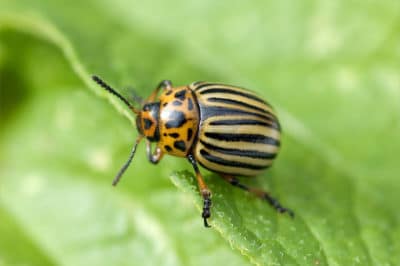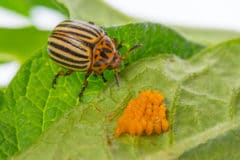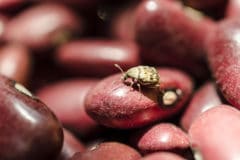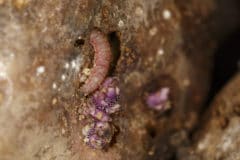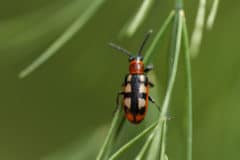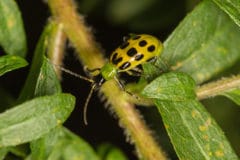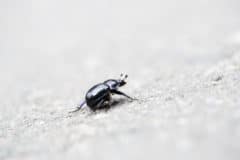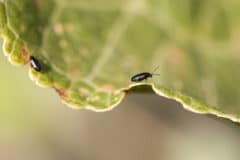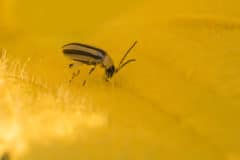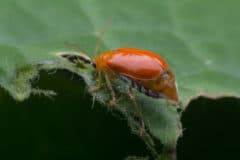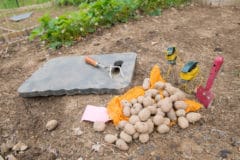Where Do Potato Beetles Come From?
The potato beetle – more correctly, the Colorado potato beetle – is native to North America. Originally, it fed on a potato relative known as buffalo bur. First collected in 1811 in the Rocky Mountains, the beetle became a major pest as humans spread across the US and began to plant potatoes. The adult beetles were able to fly fairly long distances and eventually spread across the continent. Today they are found in all states.
What Are the Signs of Beetle Infestation?
Both adult potato beetles and larvae chew on the potato leaves. They may start at the outside edge and work their way inward or cut irregular holes in the leaf surface. You won’t have to make the diagnosis by looking at the damage, however. In most cases, you’ll find beetles or larvae on the plant in addition to seeing damaged leaves. You’ll also see orange egg clusters on the leaf underside.
What Do Potato Beetles Look Like?
Potato beetles are about one-quarter inch long and about half that wide. The body shape is rounded to oval. They are typical insects, with six legs; the forelegs are smaller than the four hind legs. The beetles are an orange-yellow in color and the wings are striped in ivory and dark brown or black. Feathery-looking antennae point forward from the beetle’s spotted head.
What’s a False Potato Beetle?
False potato beetles are related to the Colorado potato beetles and have a similar appearance. However, they eat weeds rather than potato leaves. Primarily found in the mid-Atlantic and southeastern states, they appear at the same time as potato beetles. If you see what looks like a Colorado potato beetle but it has a light brown instead of ivory stripe in the center of each wing, it’s a false potato beetle.
How Do I Recognize the Larvae?
Larvae are usually an orange-pink to bright orange color. They look rather like a bloated slug with legs. All sizes of larvae have two rows of dark spots running the length of the body. The head is usually black. They are mobile and crawl around on the plant after hatching from the cluster of orange eggs the female lays on the underside of the potato leaves.
What’s the Beetle’s Life Cycle?
Adult beetles hibernate in your soil or in garden debris. They emerge in the spring and walk to the nearest plant as they don’t the energy to fly. After mating, females lay eggs that hatch in about four to 15 days depending on temperature. Larvae feed on foliage for about a month, then drop to the ground, enter the soil and pupate. They emerge as adults about five to 10 days later.
Can Potato Beetles Kill the Plant?
A serious infestation of potato beetles can decimate a potato crop by completely defoliating the plants. The most serious damage usually occurs from larvae in the late stage, just before they pupate. The beetles can produce three generations in one season, with 350 to 500 eggs per female. When potatoes are still in the vegetative growth stage, they can tolerate considerable defoliation, but once tubers begin to develop after flowering, they are much more sensitive.
Do Potato Beetles Eat the Tubers?
Potato beetles and their larvae only eat the leaves. If you have tuber damage, it’s usually something else causing the problem. Wireworms, flea beetles, potato tuberworm and white grubs are all likely candidates for tuber damage. Mice, voles and rats like to eat the tubers; you’ll usually see signs of digging or underground tunnels if these animals are the culprits.
Do Potato Bugs have Any Natural Enemies?
Unfortunately, natural enemies of the potato bug are few and unlikely to be very helpful in terms of control. Ladybird beetles, spined soldier bugs, lacewings and stink bugs will eat the eggs. A fungus called Beauveria bassiana kills both adult beetles and larvae. Barnyard poultry such as chickens, ducks and guinea hens will eat adults and larvae. However, both chickens and guinea hens will scratch in the garden, and all these birds eat plants like lettuce.
What About Planting Times?
Timing your plantings is one way to manage the potato beetle. Late summer is the worst possible time to plant, as the original adults may have produced two succeeding generations. You may have eggs, adults and larvae at that time. Planting an early crop in cool weather means less potato beetle activity, as they emerge from the soil and become more active when the weather warms.
Early, Mid-Season or Late Varieties?
Planting early season potatoes may mean you can have them out of the ground before potato beetles really become a problem. Early season potatoes are usually ready in about 75 to 90 days. These are possible choices:
- Alta Blush
- Caribe
- Chieftain
- Cobbler
- Colorado Rose
- Early Ohio
- Norland
- Satina
- Yukon Gem
- Yukon Gold
Can I Use Beneficial Insects?
The only beneficial insect you might find helpful for potato bugs is the lady bug or ladybird beetle. These insects will eat the eggs found on the underside of the leaves. However, they will not attack the adults or larvae. The other potato beetle predators are not usually commercially available. If you choose to use lady bugs, make sure you release them at the right time – follow the insectary’s directions.
Does It Help to Rotate Crops?
Crop rotation doesn’t have much of an impact when you’re dealing with potato beetles. Since the adults can fly relatively long distances, especially in warm weather, moving the plants within your garden makes no difference. In addition, the potato beetle is widespread throughout most growing regions. However, crop rotation is important for other reasons, such as preventing soil-borne disease.
What About Barriers?
Row covers, applied as soon as the plants emerge from the ground, can help prevent adult beetles from landing on the plants. The barrier must cover the entire plant and be sealed along the edges, as adults can also crawl over the ground for to up to a mile. A heavy mulch of straw makes it more difficult for the beetles to find the plants. A commercial barrier that contains kaolin clay may be helpful.
What Organic Controls Can I Use?
Dusting diatomaceous earth over the plants and soil can kill adults and larvae on contact. Insecticidal soaps that contain neem oil are sometimes effective. Sprays of the virus Beauveria bassiana and Bacillus thuringiensis var. tenebrionisare, a bacterial disease, are commercially available. Pyrethrin may also be effective. Most of these will need to be reapplied at least weekly and after a rain.
Will Trap Crops Work?
The concept behind trap crops is to attract the beetles away from your potatoes. Plant potatoes or Italian eggplants that you don’t plan to harvest around your main crop about two weeks before you plant the main crop of potatoes. In theory, the emerging beetles will head for the trap crops, which are larger and have more leaf mass. You can then remove and destroy the trap crops, beetles, larva and egg masses.
Are There Any Other Strategies?
Handpicking is effective in smaller gardens. You can remove adults and larvae this way; drop into a pail of soapy water or feed to poultry. You can also remove or crush eggs by hand. Excellent garden sanitation helps decrease places for the potato beetle to overwinter. If you use mulch, clean it up at the end of the season and compost. Turn poultry into the garden in winter to scratch and eat pupae.
Are There Any Resistant Varieties?
Although breeders have been working overtime trying to create potatoes that are resistant to the potato beetle, as of this writing there are only two known. Cornell University developed Prince Hairy and King Hairy, named for their hairy leaves. The individual hairs are filled with sticky fluid that explodes when touched. The goo traps smaller insects and apparently doesn’t taste good to the potato beetle. Limited quantities of these varieties are available.
How Do I Grow Potatoes?
Potatoes are heavy feeders and need very fertile soil with an acidic pH. They can be grown in all USDA Zones. A sandy loam provides the best texture and will drain well, which is another key element in growing potatoes. Plant as early in spring as the ground can be worked – you can chit, or pre-sprout, the potatoes to gain an earlier start. Water your potatoes regularly until the tops start to die back, then stop watering.
